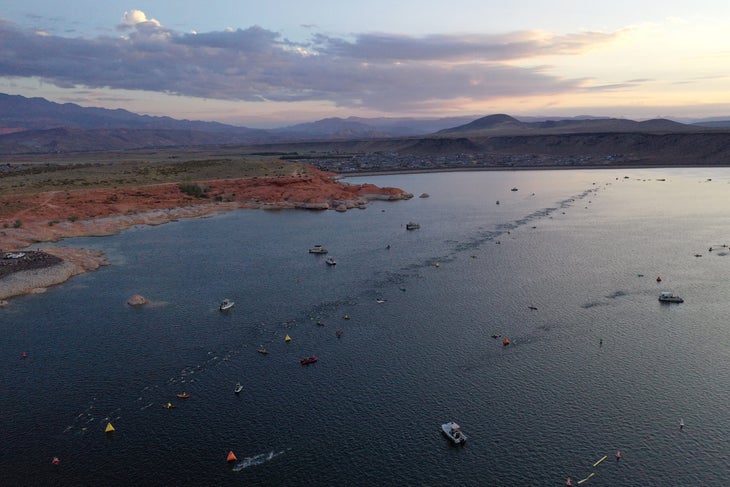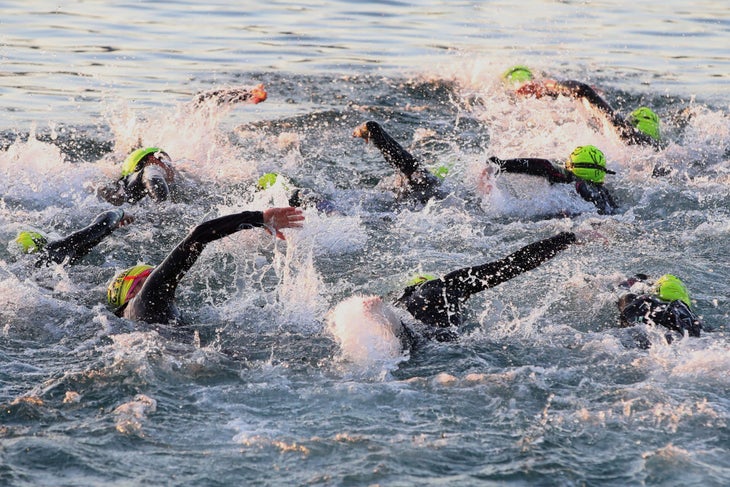New perk! Get after it with local recommendations just for you. Discover nearby events, routes out your door, and hidden gems when you sign up for the Local Running Drop.
For most triathletes, tales of open-water swimming are akin to a fisherman’s recounting of the “big one”—every time a story is told again, the fish gets a little bit bigger. But for athletes at Ironman St. George 2012, it’s hard to truly say how much of the story is exaggerated.
For starters, the water temperature at the swim start that day was a brisk 60 degrees Fahrenheit, and the air didn’t provide much respite—at 50 degrees F on race morning, many athletes in transition were bundled up in as many layers as they could comfortably wear before shedding them all to dive in.
What Brian Dunn remembers about that was how beautiful and calm it was that morning. “There were hardly any clouds in the sky, and a just light breeze,” he said of the morning. After the pro start, the age-group athletes waded into the ice-cold water, just as the sun began to peek from behind the red rocks surrounding Sand Hollow Reservoir.
Sand Hollow doesn’t have the palm trees and dolphins of Kona’s Dig Me Beach, site of the Ironman World Championship in Hawaii, but it’s a stunning swim venue nonetheless. The reservoir, filled with crisp, clear water, is surrounded by miles of red mountains, which disintegrate into rust-colored sand as it slopes into the shores of Sand Hollow. Approximately 300 meters from the boat ramp where the swim begins and ends, there is a line of tiny red islands that poke through the surface of the water. In the summertime, they are covered with children and teenagers who swim out to the rocks to do backflips and cannonballs; in the spring, wetsuit-clad triathletes are known to do the same.
Most people who race in St. George are out-of-town visitors. They arrive a few days before the event and depart shortly after. Most of their visits are not long enough to experience the true nature of St. George weather, which locals have been known to describe as “perfect, until it’s not.” The city averages 255 days of sunshine per year, and this often pushes temperatures into the 80s, 90s, and 100s. As the air heats up over the course of the day, it pushes along the hills surrounding the St. George valley, creating a weather phenomenon known as “microbursts.” These sudden wind storms appear without warning and often disappear just as suddenly, but not without wreaking havoc. St. George microbursts are known for uprooting power poles and trees, flipping boats, and generally making a mess.
In St. George, these microbursts typically happen in the late afternoon. Few people expected one to happen in the morning. Even fewer expected it to happen when more than 1,400 humans were swimming in Sand Hollow, far from shore.

The start cannon fired, and the chaos of 1,400 age group athletes set off to splash through the 2.4-mile swim course. But Dunn, a seasoned Ironman triathlete, felt off. “I can recall swimming down the lake to the turn, making a left, and noticed something odd,” said Dunn. “It looked like it was raining every time my head turned to take a breath.”
That’s weird, he thought. It’s sunny out. How is it raining?
And then the surge came. “All hell had broken loose,” Dunn said. “White-capped waves were heading directly at me, and the rain I saw was spray blowing from their tops. I went from swimming with a small group to being totally alone.”
The wind was gusting up to 40 miles per hour, creating waves over five feet high. “You would crest a wave and could sight for a moment, then you’d be in between waves again and you couldn’t see a thing,” Dunn said.
Like Dunn, age-grouper Kendra Goffredo was just trying to get through the swim. “I struggled to ignore the chaos unfolding around me, but then I heard the first cry for help. And the second. And the third. Arms shooting into the air, waving for help, begging the boats to save them,” she said. “Sand Hollow sunk into a panic; too many people, not enough boats.”
In the mayhem, communication between athletes, volunteers, and race officials broke down. Members of one swim safety boat crew mistakenly told people the swim had been canceled, pulled them onto the deck of their boats, and delivered them to shore. Other swim volunteers directed competitors to cut the course and swim straight to the finish, or to a rocky island in the middle of Sand Hollow. In all, dozens of athletes were pulled from the water and hundreds more did not finish under the swim cutoff time of 2 hours, 20 minutes.
Those who did make it to the swim exit emerged from the water gobsmacked. “I entered T1 laughing out loud at the absurdity of how hard the wind was blowing,” Dunn said. “On my bike, I literally had to lean over to keep the wind from knocking me down. Headwinds, crosswinds, tailwind…it was chaos and carnage.”
RELATED: Everything You Need To Know About the Ironman St. George Course
For the first time in Ironman history, race officials decided to let anyone who was pulled from the water or finished after the swim cutoff time continue on in the race if they wished. Many, shell-shocked and exhausted from the efforts of the swim, didn’t take them up on that offer; most of those who did, made it to the finish line. In all, 29 percent of athletes who started the race did not finish. It was the death knell for the full Ironman in St. George, which had already garnered a reputation for being “too hard” due to massive elevation gains on the bike and run courses. The race was shortened to a half in 2013.

In the immediate aftermath of the freak weather event, triathlon race officials around the globe dissected what happened at Ironman St. George in hopes of understanding everything that went wrong and how to avoid similar chaos at future races. And when the full Ironman St. George was revived to host the Ironman World Championship race in May of 2022, officials had a decade of experience creating and implementing successful swim safety plans to ensure what happened in 2012 wouldn’t happen again.
RELATED: How to Watch the Ironman World Championship in St. George
“Athlete safety is always our number one priority,” said Judy Stowers, who took over as Ironman St. George race director for 2022. “As far as the weather is concerned, race day is always going to be unpredictable. Race week is unpredictable. But behind the scenes, we do everything that we can to prepare for all of those different variables, to make sure that the athlete’s safety is secured.”
What Stowers describes as a “robust swim safety plan” includes multiple city, county, and state agencies working together before and during the race to communicate water and wind conditions. For the World Championship race, there will be an increase in sighting buoys along the course and additional watercraft to assist athletes when needed.
“We know collectively that things can happen, and we’re prepared for that from a safety standpoint,” Stowers said. “We have our emergency plans in place. We’re ready.”
When Goffredo encounters athletes training for St. George, she encourages them to be ready, too. Her advice for those racing in May: “In the months leading up to the race, take every opportunity to train in the worst weather possible, whatever that might mean for you.”
RELATED: How the St. George Course Will Create a New Race Dynamic
Can’t get enough Ironman World Championship coverage? Bookmark this page for the latest news and insider info from St. George.
